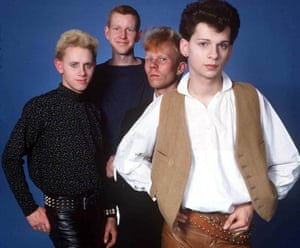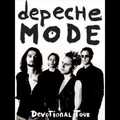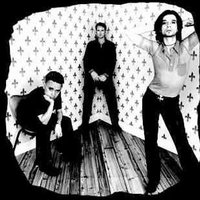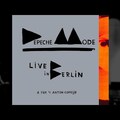Last week, they were forced to deny being the official band of the alt-right. In fact, from synthpop to sleaze rock, Depeche Mode are a vital group

1. Photographic (Some Bizzare version)
In 1980, Daniel Miller created a virtual electropop band called Silicon Teens, featuring four fictionalised teenagers whose sound derived entirely from synthesisers. The following year, the real thing arrived. Miller, who was running Mute Records, came across Depeche Mode, a quartet of teenagers – and one 20-year-old in the shape of songwriter Vince Clarke – from Basildon, Essex. “They were kids, and kids weren’t doing electronic music at the time,” said Miller. “It was people who’d been to art school mainly, but Depeche Mode weren’t processed by that aesthetic at all.” Stevo Pearce of the Some Bizzare label had also noticed the group (as had a few majors, who had to be repulsed), and Miller licensed Depeche Mode’s first track, Photographic, to Pearce for Some Bizzare’s Futurism compilation. Photographic was the standout track on the collection, and received much of the critical attention. The band rerecorded it for their debut album Speak & Spell, though the Some Bizzare version is more naively charming, bolshy and brutalistic. It tears along with clean synth lines bleeding into the red, marrying Numanoid keyboard monoliths with dispassionate Kraftwerkian sprechgesang, with an added touch of voyeuristic perviness about it. From the off, Depeche Mode were showing tremendous promise.

2. Everything Counts
It could have been curtains when Clarke left after the first album, but the remaining members (plus Alan Wilder, initially hired for live outings) had faith in the songwriting abilities of Martin Gore. The group also got their hands on a Fairlight synthesiser, which, although prohibitively expensive at the time, would enable them to turn their music into something more doomy and industrial. The third Depeche album, Construction Time Again, featured an assemblage of drubbed scrap metal noise, sampled and manipulated, with the track Pipeline made up entirely of field percussion from found sounds. More radio friendly was Everything Counts, a critique of greed, written as Margaret Thatcher’s first term shaded into her second. The “grabbing hands grab all they can” lyric captured the zeitgeist; the juxtaposition of the main hook ringing like a till with the more exotic Chinese oboe exemplifies a clash of civilisations and, perhaps, an exhortation to choose between the worldly and the spiritual. Gore’s lyrics are usually heartfelt, often leading to accusations of naivety, and while Everything Counts is largely coherent in its message, “The turning point of a career / In Korea / Being insincere” must rank as one of the worst lyrics ever written. Still, it’s a competitive world, and its catchy pop sloganeering took it to No 6 in the UK charts.
3. Shake the Disease
Arriving in 1985 as a supplementary track to promote their first singles compilation, Shake the Disease proved that electronic songs could be just as moody and dynamic as their rock counterparts. Depeche Mode’s 13th single, recorded in Berlin (at the Hansa studio where Bowie recorded Heroes) is a masterclass in emotional nuance. Shake the Disease was not only the band’s best track to date, it also featured Dave Gahan’s finest vocal to date, with his emotional rasp counterpointing Gore’s minor baroque flourishes in the chorus. Opening line “I’m not going down on my knees / Begging you to adore me” is ambiguous enough to tacitly invite questions about sexuality, reinforced by Gore’s imploring “understand me” (which becomes yet more effective when sung in leather fetish wear). And then of course there’s that title, which would have been topical in 1985 with fears about HIV on many listeners’ minds. Shake the Disease stalled just inside the Top 20, probably because of the titular implications.
4. But Not Tonight
The B-side to the 1986 single Stripped is an oddity in the canon post-Vince Clarke, in that it celebrates exhilaration rather than despondency, albeit in a very Depeche Mode kind of way (“Oh God, it’s raining, but I’m not complaining / It’s filling me up with new life”). It’s characteristically sombre for the opening 16 bars or so, but then But Not Tonight inexplicably speeds up and continues at the same pace to the end. Gahan makes reference to the “constant debauchery” that would become somewhat more troublesome in future years, and marvels at how he hasn’t “felt so alive in years”. Such gratuitous positivity was considered more suitable for American listeners, and so But Not Tonight and Stripped were flipped for the US market. It was also used as the soundtrack for the all-but-forgotten Virginia Madison vehicle Modern Girls, but despite the extra publicity, But Not Tonight failed to chart across the pond. Depeche Mode needn’t have been downhearted. Their music was soon to catch on in a very big way in the US.
5. Never Let Me Down Again
In 1987, Depeche Mode ramped things up again, with someone describing the band as suddenly “making self-destruction sound like falling through the clouds”. The basis for this track came from the unlikeliest of sources, with programmed beats built around the drum intro from Led Zeppelin’s When the Levee Breaks. On top of that groove were added polyphonic textures, a change from the strictly monophonic keyboard lines of yore, but the genius of Never Let Me Down Again lies in the urgent but monotone vocal from Gahan, always breaching the blue notes but never quite resolving, set against the sophisticated musical tapestry beneath. The song again hints at something intimate and sexual (“Promises me I’m safe as houses / As long as I remember who’s wearing the trousers”), while others have suggested that it’s a love letter to drugs. Interestingly, Never Let Me Down Again peaked outside the Top 20, and there were fears that Depeche Mode’s popularity was on the wane. In fact it was the anticlimactic start of a stealthy rise to world domination, the ripples from a pebble that would lead to a tsunami of popularity.
6. Behind the Wheel
The follow-up single to Never Let Me Down again was just as good, and like its predecessor, it was another crepuscular journey with plenty of ambiguity about what was actually going on. The Music for the Masses album saw Gore take control, leaving producer Dave Bascombe a little frustrated that he had to follow the polished demos as closely as possible. He told biographer Steve Malins: “I wasn’t allowed to have a hi-hat on that song, which made it very hard to get a groove going.” Bascombe did concede, however, that the “claustrophobic, unique sound [was a success] because of the limitations”. The band were becoming more interesting visually, too, with video collaborations with Anton Corbijn giving them an air of aloof, monochrome mystery, while 101, a movie directed by DA Pennebaker of Don’t Look Back and Ziggy Stardust fame, brought them to the masses through the medium of cinema.
7. Personal Jesus
Depeche Mode’s creative purple patch continued unabated with Personal Jesus, a glam-stomping, heavy breathing, techno romp that made a show of its absorption of the guitar. Gore had often written on a six-string in his hotel bedroom and then transposed the work to keyboards later, but here he was unashamedly plucking away (and looping) an addictive, note-bending hook that was more beholden to the blues than Neu! Personal Jesus sold more than 1m copies in the US, but not before the censors at MTV removed problematic frames from the Corbijn-directed video. “The shot of the horse’s arse comes when there’s all this heavy breathing on the track,” an incredulous Gore told Stephen Dalton of Uncut. “I don’t know if Anton was consciously trying to be perverted, I think it was more coincidental that it happened at that point. These video people see things very strangely.”
8. Enjoy the Silence
It’s perhaps ironic that Depeche Mode’s most loved and immediately recognisable song begins by sounding more like New Order. Dele Fadele, writing for NME in 1993, said it “crystallises melancholy New Order”, though when Gahan starts to sing, you are pulled back into familiar territory. Enjoy the Silence is vintage Depeche Mode, containing all the elements that make their records great. A Teutonic groove? Check. Emotional, minor-key soundscapes? Check. Gahan’s dulcet tones allowing the synthesisers to do the heavy lifting? Check. A plaintive, simplistic yet brutally effective Gore lyric? In fact the words, which convey a single moment of physical tenderness where any utterance would ruin it, are as moving on the page as they are on the single itself.
9. Condemnation
Gahan, who’d taken to hard living in Los Angeles by the early 90s, was all ready to leave Depeche Mode until he heard the demo for Condemnation. “It was a total relief!” he said, “I couldn’t believe it.” Purist Modies who’d followed the band from the outset would probably have balked at the utilisation of gospel choirs, blues piano and overdriven guitars at the beginning, and yet in the grunge era, Depeche Mode proved they were as relevant as ever. The song had actually been earmarked by Gore for his customary album track ballad, but Gahan hijacked the session, and his insistence that he sing it proved canny. From somewhere the singer produced his finest vocal performance, a visceral, desperate and despairing musical jeremiad summoning the spiritual oasis he’d found within himself. Gahan had bought into the rock’n’roll myth hook, line and sinker, and those closest to him feared things would not end well.
10. Freelove
In May 1996, Gahan overdosed on a speedball in downtown LA. Though his heart stopped for two minutes, he pulled through. By 2001, he’d come a long way from the blacked-out Los Angeles heroin den he nicknamed the Purple Palace (so called, Gahan said, “because so many people turned blue there”), and while Depeche Mode were well beyond their imperial phase, they still had the capacity to write a song as gorgeous as Freelove now and again. Though written by Gore, the “No hidden catch / No strings attached / Just freelove” lyric tapped into Gahan’s unconditional love for a newborn. “I’ve realised now that you’ve got to get really quiet and stop and get slow to really feel what’s going on with yourself,” he told Malins. “And it’s hard to do that out there in the world where it’s all white noise static … but you can do if you get quiet and slow. And I know it sounds hokey, but I felt that when my baby daughter was born and I picked her up. I felt life. And I felt love.”



